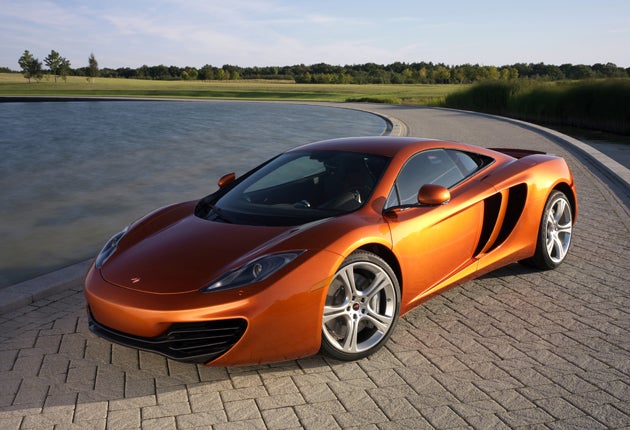McLaren MP4-12C
McLaren's first 'supercar' has 45 years of racetrack expertise behind it

'It's really great," concurred Jenson Button and Lewis Hamilton, who know better than most what a really fast car with a McLaren badge should feel like.
They were standing in front of the new McLaren MP4-12C, and they had remembered their scripts well. Ron Dennis, nowadays masterminding McLaren Automotive, the new road-car company, rather than the F1 team, spoke much of "passion" in the way modern business does.
A film showed a pair of matt-black MP4-12Cs being hurled around the Goodwood race circuit by the British world champions. The cars looked low, sleek, compact, glued to the track: this is not an over-wide, look-at-me supercar, impractical for day-to-day use, but a car able to fit real roads and soak up their imperfections with a lightness of touch.
"It's a tactile car, and that's the starting point for a McLaren," says suspension engineer Chris Goodwin. "A McLaren must have genuine performance you can use, especially in cornering. This is a car able to handle autobahns or the Nürburgring Nordschleife [the tortuous racetrack that is the acid test of any supercar's mettle], yet even at low speeds it has really satisfying feel and feedback."
And then I arrived at Goodwood House later that day for a press preview of July's Festival of Speed and September's Revival race meeting, and I was fortunate enough to drive a new Audi R8 V10 Spyder up the hillclimb. Immediately in front of me in the queue was, yes, Chris Goodwin in one of the black McLarens. So I was one of the first outside the company to hear it driven in anger, and perfectly placed for the ultimate sound effects.
Flag down, off it went: the sound was a deep throb, not the howl I expected. And that's the point. The MP4-12C is designed to be an efficient, focused driving tool, not a profligate show-off machine. True, the first fully-finished example is in a lurid metallic orange, but it wears that hue only because 1960s McLaren racing cars were usually also orange.
At McLaren, you sense that absolutely nothing is skimped. The Formula One business is clearly lucrative, judging by the Norman Foster-designed headquarters building, and sufficiently so to finance, with help from outside investors, the development of a new car and the whole sales and service back-up to accompany it. So what, then, is this MP4-12C exactly?
It is a two-seater, mid-engined, closed-roof sports car designed to compete with a Ferrari 458, a Lamborghini Gallardo, or a high-end Porsche 911. It will cost around £150,000, production begins next year, McLaren plans to make 1,000 in the first year and expects the project to be profitable within four years.
Fine. But why wouldn't you just buy a Ferrari? Because the McLaren is an excitingly fresh take on the whole supercar idea and a fabulously hi-tech, obsessively engineered creation.
For example, the carbonfibre "tub" that forms the central structure weighs just 80kg and is made from a single mould, despite containing hollow sections. It's so strong that the same tub survived three separate crash tests. Then there's the engine. McLaren looked at adapting an existing V8 engine block from another carmaker, but nothing was suitable without extensive re-engineering, so the company decided to design its own engine from scratch.
The result is a 3.8-litre, twin-turbocharged V8 which sits low in the structure for optimum handling, necessitating a separate oil tank. The M838T engine produces 600bhp. It also produces 443lb/ft of torque, of which at least 369lb/ft is available all the way from 2,000rpm to 8,500. All this energy is channelled to the rear wheels via a seven-speed, double-clutch, sequential transmission. From a standstill, 124mph (that is, 200km/h) arrives in under 10 seconds, and the MP4-12C can stop from 62mph in 30 metres.
Formula One technology has played a big part in the structure, the engine, the transmission, and the aerodynamics, and the F1 team's expertise in electronics has helped greatly in the suspension and the adaptive dampers it contains. There's a system called Brake Steer, which selectively applies individual brakes to help point the MP4-12C more swiftly to where its driver demands, and there's an electro-hydraulic anti-roll system to keep the car flat in corners while letting it soak up bumps easily on a straight road.
This is McLaren's fourth road car but it's the first one created fully in-house, engine and all, with no parts shared with anything else. After 45 years of existence, McLaren is poised to become a fully-formed car manufacturer.
Other McLarens will follow, all of them two-seater sports cars, some considerably more affordable than the MP4-12C. Some may be hybrids, all will ooze technology, fuel-efficiency, and the obsessive weight-saving that all future cars must embrace.
On which subject, here's a final vignette. The magnesium beam on which the dashboard is hung bears a McLaren logo. Initially, the logo was embossed, but that meant an excess of protruberant metal. So the letters were recessed instead, saving 2.4 grams. Repeat that mindset many times over, and you'll understand just what the MP4-12C is about.
Subscribe to Independent Premium to bookmark this article
Want to bookmark your favourite articles and stories to read or reference later? Start your Independent Premium subscription today.

Join our commenting forum
Join thought-provoking conversations, follow other Independent readers and see their replies